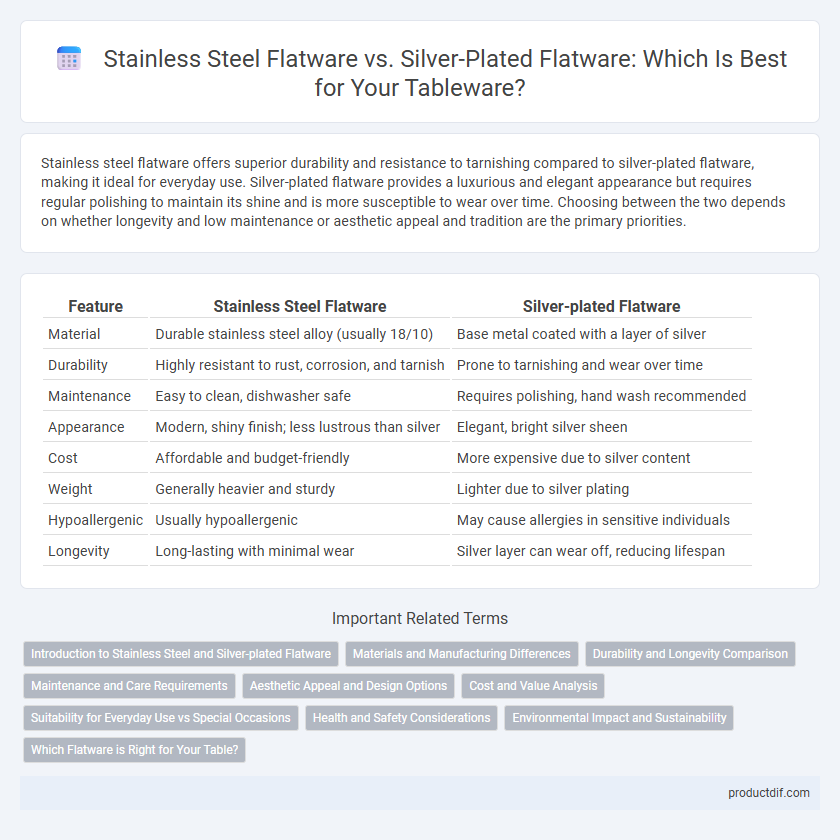Stainless steel flatware offers superior durability and resistance to tarnishing compared to silver-plated flatware, making it ideal for everyday use. Silver-plated flatware provides a luxurious and elegant appearance but requires regular polishing to maintain its shine and is more susceptible to wear over time. Choosing between the two depends on whether longevity and low maintenance or aesthetic appeal and tradition are the primary priorities.
Table of Comparison
| Feature | Stainless Steel Flatware | Silver-plated Flatware |
|---|---|---|
| Material | Durable stainless steel alloy (usually 18/10) | Base metal coated with a layer of silver |
| Durability | Highly resistant to rust, corrosion, and tarnish | Prone to tarnishing and wear over time |
| Maintenance | Easy to clean, dishwasher safe | Requires polishing, hand wash recommended |
| Appearance | Modern, shiny finish; less lustrous than silver | Elegant, bright silver sheen |
| Cost | Affordable and budget-friendly | More expensive due to silver content |
| Weight | Generally heavier and sturdy | Lighter due to silver plating |
| Hypoallergenic | Usually hypoallergenic | May cause allergies in sensitive individuals |
| Longevity | Long-lasting with minimal wear | Silver layer can wear off, reducing lifespan |
Introduction to Stainless Steel and Silver-plated Flatware
Stainless steel flatware offers durability, corrosion resistance, and low maintenance, making it ideal for everyday use and modern dining settings. Silver-plated flatware features a thin layer of silver over a base metal, providing a classic, elegant appearance suitable for formal occasions but requiring careful handling to prevent tarnish. Both materials deliver distinctive aesthetics and functional benefits, with stainless steel favored for practicality and silver-plated for traditional luxury.
Materials and Manufacturing Differences
Stainless steel flatware is crafted from durable alloys typically containing iron, carbon, chromium, and sometimes nickel, producing corrosion-resistant, low-maintenance utensils through high-temperature forging or stamping processes. Silver-plated flatware features a base metal such as nickel or copper coated with a thin layer of pure silver via electroplating, requiring careful craftsmanship to ensure uniform silver deposition and preservation of intricate designs. These material and manufacturing distinctions influence longevity, appearance, and care requirements between the two types of flatware.
Durability and Longevity Comparison
Stainless steel flatware offers superior durability due to its resistance to rust, tarnish, and corrosion, making it ideal for daily use and dishwasher cleaning. Silver-plated flatware, while elegant, tends to wear down over time as the silver layer thins, requiring more careful handling and maintenance to preserve its appearance. In terms of longevity, stainless steel flatware generally outlasts silver-plated options, maintaining its structural integrity and finish with minimal care.
Maintenance and Care Requirements
Stainless steel flatware requires minimal maintenance, as it resists rust, tarnishing, and corrosion, allowing for easy dishwasher cleaning without special care. Silver-plated flatware demands regular polishing to prevent tarnish and can be damaged by harsh detergents or prolonged exposure to moisture, necessitating hand washing and gentle drying. Proper storage for silver-plated sets involves anti-tarnish cloths or pouches, ensuring longevity and maintaining their aesthetic appeal.
Aesthetic Appeal and Design Options
Stainless steel flatware offers a sleek, modern aesthetic with a polished or matte finish that complements contemporary table settings, while silver-plated flatware provides a classic, luxurious appearance with intricate patterns and ornate designs. The durability of stainless steel allows for minimalist and versatile design options, whereas silver-plated flatware often showcases elaborate craftsmanship suitable for formal occasions. Choosing between the two depends on the desired balance between timeless elegance and practical longevity in tableware aesthetics.
Cost and Value Analysis
Stainless steel flatware offers a cost-effective alternative with high durability and resistance to tarnish, making it ideal for everyday use and long-term value. Silver-plated flatware, while more expensive initially due to its attractive aesthetic and status appeal, requires regular maintenance to prevent wear and tarnish, potentially increasing long-term costs. Evaluating the balance between upfront investment and upkeep expenses highlights stainless steel flatware as the more practical and economically sound choice for most households.
Suitability for Everyday Use vs Special Occasions
Stainless steel flatware offers exceptional durability and resistance to rust and tarnish, making it ideal for everyday use and frequent washing. Silver-plated flatware, while elegant and visually appealing, requires more careful handling and polishing, better suited for special occasions and formal dining. The practicality of stainless steel aligns with daily meals, whereas silver-plated enhances the aesthetic of celebratory settings.
Health and Safety Considerations
Stainless steel flatware is highly resistant to rust, corrosion, and staining, making it safer for everyday use and reducing the risk of metal leaching into food. Silver-plated flatware, while elegant, can wear down over time, potentially exposing the base metals underneath, which may cause allergic reactions or toxicity in sensitive individuals. Choosing high-quality stainless steel flatware ensures durability and a non-reactive surface, promoting better health and safety during meals.
Environmental Impact and Sustainability
Stainless steel flatware boasts superior environmental benefits due to its recyclability and long lifespan, reducing waste and resource consumption compared to silver-plated flatware, which involves more intensive mining and plating processes with higher ecological footprints. The durability of stainless steel eliminates frequent replacement, promoting sustainability through reduced material demand and energy use. Silver-plated flatware, while aesthetically appealing, requires more maintenance and eventual disposal presents challenges because of its mixed-metal composition, impacting its overall environmental sustainability negatively.
Which Flatware is Right for Your Table?
Stainless steel flatware offers unmatched durability, resistance to rust, and affordability, making it ideal for everyday use and casual dining. Silver-plated flatware provides an elegant, timeless aesthetic with a luxurious finish, perfect for formal occasions and special events but requires regular polishing to maintain its shine. Choosing between stainless steel and silver-plated flatware depends on your lifestyle needs, maintenance preference, and the desired level of sophistication for your table setting.
Stainless Steel Flatware vs Silver-plated Flatware Infographic

 productdif.com
productdif.com